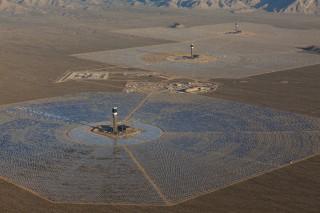
U.S. solar jobs are up 19.9% since last year, two “world’s largest” solar projects are now operational, a number of studies address the issue of energy and climate change, global wind energy capacity grows 12,5% in 2013 but the growth somewhat slows in the EU. We have collected all these stories and more of the most important energy news of the past month conveniently in one place for you to read.
Wind Energy
This February, the Global Wind Energy Council (GWEC) released its 2013 market statistics, with cumulative global wind energy capacity reaching a total of 318,137 MW, an increase of nearly 200,000 MW in the past five years. However, according to the report, the annual market dropped by almost 10 GW to 35,467 MW, attributable to the precipitous drop in US installations due to the policy gap created by the US Congress in 2012. While 2013 marked another difficult year for the industry with “only” 12.5% cumulative global wind energy capacity growth, the prospects for 2014 and beyond look much brighter.
Meanwhile, according to the latest report by The European Wind Energy Association (EWEA), during 2013, 10,917 MW of new wind energy capacity came on line in the EU-28, a decrease of 8% compared to 2012. There are now 116,774 MW installed the EU, meeting 8% of EU electricity demand, and a further 4,188 MW in the rest of Europe. At the same time, leading European companies are calling for an ambitious EU renewable energy target, including binding national targets.
In a new study, researchers from Imperial College Business School carried out a comprehensive nationwide analysis of the UK fleet of wind turbines, using local wind speed data from NASA. They showed that the turbines will last their full life of about 25 years before they need to be upgraded. The study also found that more recent turbines are performing even better than the earliest models, suggesting they could have a longer lifespan. The team says this makes a strong business case for further investment in the wind farm industry.
Another study, this time by the USGS scientists, is assessing wind energy impacts on wildlife at a national scale. The USGS has already created a publicly available national dataset and interactive mapping application of wind turbines. This dataset is built with publicly available data, as well as searching for and identifying individual wind turbines using satellite imagery. The locations of all wind turbines, including the publicly available datasets, were visually verified with high-resolution remote imagery to within plus or minus 10 meters.
Solar Energy
At the end of January, the Solar Foundation released its National Solar Jobs Census 2013, which found that the U.S. solar industry employed 142,698 Americans as of November 2013. This figure includes the addition of 23,682 solar workers over the previous year, representing 19.9 percent growth in employment since September 2012. During the period covered by the Census, solar employment grew 10 times faster than the national average employment rate of 1.9 percent. This growth rate is also significant in that it shows—for the first time ever—the solar industry exceeded the growth projections made in the previous year’s report.
The most popular posts in February, 2014
1. Scientists Discover Crude Oil Cardiotoxicity Mechanism in Fish
2. Solar-Induced Fuel Cell Converts Biomass to Electricity
3. Scientists Make Gasoline-Like Fuel From Plant Waste
4. U.S. Solar Jobs Up 19.9% Since Last Year
5. Piezoelectric Devices Harvest Energy From Heart, Lungs, Diaphragm
According to the recent announcement by the Energy Department, the U.S. solar industry is more than 60 percent of the way to achieving cost-competitive utility-scale solar photovoltaic (PV) electricity—only three years into the Department’s decade-long SunShot Initiative. In the United States, the average price for a utility-scale PV project has dropped from about $0.21 per kilowatt-hour in 2010 to $0.11 per kilowatt-hour at the end of 2013. According to the Energy Information Administration, the average U.S. electricity price is about $0.12 per kilowatt-hour.
Within the past few years, utility-scale PV has risen from a relative newcomer to the solar market to the fastest growing sector of the industry. These projects feature large, centralized PV systems that feed power directly to the grid. While the operating history of utility-scale PV is brief, it is expected to dominate the overall PV market through 2016, helping create new jobs, support domestic manufacturing and boost economic growth as it expands.
On February 13, NRG Energy, Inc. announced that that the world’s largest solar thermal project, the 392 MW Ivanpah Solar Electric Generating System, is now operational and delivering solar electricity to California customers. At full capacity, the facility’s trio of 450-foot high towers produces a gross total of 392 MW of solar power, enough electricity to provide 140,000 California homes with clean energy and avoid 400,000 metric tons of carbon dioxide per year, equal to removing 72,000 vehicles off the road. The project is the first to use BrightSource’s innovative solar power tower technology to produce electricity, which includes 173,500 heliostats that follow the sun’s trajectory, solar field integration software and a solar receiver steam generator.
Though, according to a report by the Energy Department’s National Renewable Energy Laboratory, different concentrating solar power (CSP) technologies deliver similar value. “In our study, we analyzed various plant configurations and identified specific ones that provide significantly more value than has been found in previous analyses,” said NREL Analyst Jennie Jorgenson, the lead author of the report. “For example, we explored the potential benefits of extending thermal storage at CSP plants beyond six hours, a typically modeled amount. In this analysis we found additional benefits for six to nine hours of storage, but rapidly diminishing benefits for greater than nine hours of storage.”
Meanwhile, Blackfriars Bridge, part of Blackfriars station in London, has been fitted with 4,400 solar panels, making it the largest solar bridge in the world. Networkrail—owner and operator of Britain’s railway infrastructure, developer Solarcentury and train operator First Capital Connect had a free hot beverage for every commuter passing through Blackfriars station in the morning, drawing attention to the fact that the solar bridge generates enough energy for 80,000 cups of tea a day.
The project is one step in the £6.5bn ($10.82bn) Thameslink program, to improve public transport in the busy English capital. Through its prominent position close to many popular tourist spots and its high visibility for commuters, the solar array at Blackfriars Rail Bridge will do its fair share to promote renewable energies and stand as a landmark project for sustainable city development.
Energy and Climate Change
A University of California, Davis, study “Science and the Stock Market: Investors’ Recognition of Unburnable Carbon” found that investors in U.S. oil and gas companies do not really fear that climate change regulations could force fossil-fuel companies to leave large reserves of oil, gas and coal in the ground untouched in order for the world to avoid global warming. Researchers found that there was only a limited negative impact on stock prices of fossil-fuel companies in response to a study which found that only a fraction of the world’s oil, gas, and coal reserves could be emitted if global warming by 2050 is not to exceed 2 degrees Celsius above pre-industrial levels.
In the UK, the public’s support for fracking is continuing to wane, despite attempts by energy companies to offer “benefits” to local communities as compensation for fracking, according to a new report by experts at The University of Nottingham. Professor Sarah O’Hara, from the University’s School of Geography, who led the study along with Professor Matthew Humphrey from the School of Political and International Relations, said: “Although respondents do see shale gas as a ‘cheap’ form of fuel, the trends have also moved away from shale on this indicator which in July 2013 stood at +33.4 per cent, but had fallen to +26.3 per cent in September and is now +22.7 per cent. This suggests that the ‘turn against fracking’ indicated in September was not a ‘blip’ and may represent an increasing sense of unease with the environmental implications of fracking techniques amongst the UK public.” The trend is also seen in the more general question of whether fracking should be allowed in the UK, where a 39.5 per cent differential in favor of shale gas extraction in July 2013 has been pared back to +26.7 per cent in January 2014.
Another report called “The Impact of Oil & Gas Drilling Accidents on EU Fisheries” by Dr David Green and Dr Cristina Gomez of the University of Aberdeen’s Institute for Coastal Science and Management (AICSM) provided for the first time a review of oil and gas related incidents and accidents in relation to fisheries in EU waters. The report highlights an overall decline in the number of offshore oil & gas drilling accidents since the industry’s birth, as well as a decline in the impact these accidents have on the environment and fisheries. The study notes that historically, tanker spills were the cause of the majority of oil spills in European waters, but this has declined as the result of more oil being transported through pipes, and the improvement in tanker safety features and technology. It also mentions that although exceptional incidents such as oil rig blow outs and tanker spills have the largest short-term impact on the environment and on fisheries, small accidents have an unknown impact in the long-term.
The International Atomic Energy Agency (IAEA) delivered its final report on Fukushima decommissioning to the government of Japan on 12 February 2014. At Japan’s request, the IAEA organized two expert teams to provide an independent review of Japan’s Mid-and-Long-Term Roadmap towards the Decommissioning of TEPCO’s Fukushima Daiichi Nuclear Power Station Units 1-4. The first team visited Japan from 15 to 22 April 2013 and the second from 25 November to 4 December 2013.
“Japan has established a good foundation to improve its strategy and to allocate the necessary resources to conduct the safe decommissioning of Fukushima Daiichi,” said team leader Juan Carlos Lentijo, IAEA Director of Nuclear Fuel Cycle and Waste Technology. “The situation, however, remains very complex, and there will continue to be challenging issues that must be resolved to ensure the plant’s long-term stability.”
In the meantime, a study led by Stanford University that involved researchers from the University of Michigan, MIT, Harvard University and 11 other institutions and national laboratories, found that America’s natural gas system is leaking methane: About 50 percent more of the greenhouse gas methane has been seeping into the atmosphere than previously thought. The Environmental Protection Agency and other organizations have consistently underestimated methane leakage, the study says. But the amount that’s presently escaping from faulty oil and gas infrastructure would not be enough to reverse the climate benefits of burning natural gas instead of coal to make electricity.
This month in photos: February 2014

An aerial view of the Ivanpah Solar Power Facility with left to right Tower 1, 2 and 3. (Credit: BrightSource Energy)

The mechanical energy harvester, which is flexible enough to conform to the surface of an organ such as the heart, converts the organ’s motion into electricity. (Credit: Univ. of Illinois / Univ. of Arizona)

The Heatworks Model 1 measures a length of 12.5 (32 cm) inches and 6 inches (15 cm) in diameter. (Credit: Kickstarter)

A new fuel cell demonstration project led by Sandia National Laboratories will feature a portable, self-contained hydrogen fuel cell unit currently in the design phase. Once completed, it will be deployed to the Port of Honolulu by Young Brothers, Ltd., one of the project partners and a primary shipper of goods throughout the Hawaiian Islands. (Credit: Young Brothers, Ltd.)

Wake Forest biology graduate student Max Messinger and biology professor Miles Silman pose with their remote controlled helicopter and fixed-wing aircraft on Davis Field on Friday, January 31, 2014. The aircraft are used to create photo mosaics for ecological monitoring. (Credit: Wake Forest University)

The microbattery created by Jie Xiao and Daniel Deng and colleagues, amid grains of rice. (Credit: PNNL)

